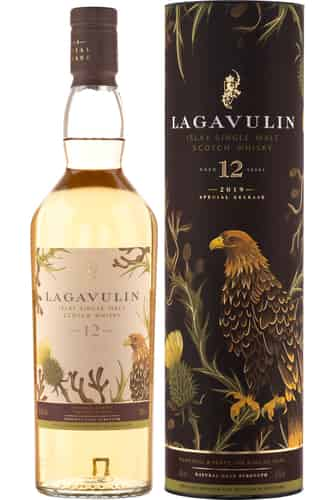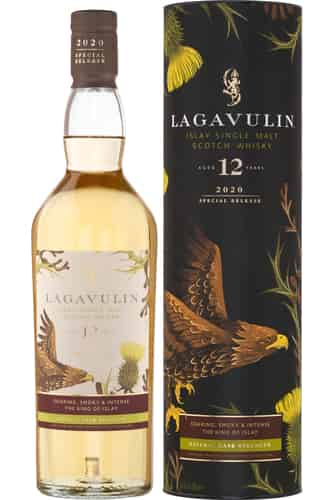Lagavulin

Lagavulin 12 Year Old (2019 Special Release)
70 cl, 56.5%In stock128.80 €
Lagavulin 12 Year Old (2020 Special Release)
70 cl, 56.4%In stock128.80 €![]()
Lagavulin Distiller's Edition
70 cl, 43%In stock97.60 €![]()
Lagavulin 12 Year Old (2022 Special Release)
70 cl, 57.3%In stock139.20 €![]()
Lagavulin 16 Year Old
70 cl, 43%In stock87.20 €![]()
Lagavulin 8 Year Old
70 cl, 48%In stock63.20 €
Sorry, we didn't find anything. Please try changing your search criteria.
Lagavulin History
Between the two Islay powerhouses of Ardbeg and Laphroaig lies a third mighty distillery: Lagavulin. Lagavulin’s oleaginous and smoky malt whisky has remained ever popular. The distillery’s 16 year old offering is perhaps the greatest icon of Islay whisky, alongside Laphroaig 10. In recent years, the whisky’s popularity has been ensured as it is a favourite of Ron Swanson, of Parks and Recreation fame. Due to the sherry influence and oaky notes in the whisky, it has been named "The Cognac of Whiskies".
Lagavulin starts its life like so many Islay whiskies, as Optic malt from the Port Ellen maltings, peated to 35ppm. This is then ground by a Porteous mill, before transfer to a stainless steel mash tun. Lagavulin employs a slightly unusual mashing technique of continuous process, as opposed to separate waterings, this is done at 68Co. The mash is then moved to 10 washbacks, made from Larch as opposed to the more conventional Oregon pine. Here Mauri and Quest yeast is added at a 50:50 ratio, and the mix is fermented for 55 hours at 16Co.
The distillery is known for its 4 onion shaped stills, the wash stills of which have a capacity of 12,300 litres each, and are heated by both steam coils and pans. The wash stills are quite high, at nearly 7 metres. Once the wort is pumped into them, the low wine run takes about four hours. The spirit stills are a little bit smaller, at only 5.7 metres, but have a larger capacity of 12,900 litres. They are heated only by steam coils. The foreshots run lasts half an hour, with the spirit run taking 5 hours, and the feints run taking a fraction less at 4 hours 30 minutes. This slow distillation is said to give the spirit some of its oily character.
The spirit is then casked, the majority in third fill American oak barrels, with a small amount in third fill European sherry casks, and smaller still in casks of Pedro Ximenez. Lagavulin has three warehouses on site, close to the ocean, so absorbing of some maritime qualities. The distillery makes use of its connection with other Diageo owned establishments, keeping another 9 warehouses at Port Ellen and 1 at Caol Ila. All are dunnage style.
Lagavulin has a long history, with evidence of up to ten illicit stills on the site from 1742. Fast forward to 1816, and the harmoniously named John Johnston has founded the first legal distillery on the site. Within a year, a second distillery, by the name Ardmore, had sprung up nearby, founded by a one Archibald Campbell. When John Johnston died, the two distilleries were combined, after a merchant named Alexander Graham purchased the distillery for just over £1100 (about £33000 in today’s money). Graham improved facilities at the distillery, making repairs and rebuilds where necessary. In 1867, the famous Mackie whisky family gained control of Lagavulin, managed by John Logan Mackie. When John died, management was passed to his nephew, Peter Mackie.
Peter Mackie was an extraordinary and eccentric figure. Upon taking over at Lagavulin he immediately set up the famous White Horse blend, in which the distillery still plays a small role. This was made for export and brought Lagavulin spirit to people around the world. Peter Mackie also founded the now quasi-mythical distillery Malt Mill, immortalised in the 2012 film The Angels’ Share. Yet, this elusive spirit has spite and controversy to thank for its birth. For many years, Laphroaig whisky had been sold by Lagavulin, with the latter distillery acting almost as "brand ambassadors" for the former. Yet in 1907, Laphroaig decided that they could now sell their own whisky, cutting out the middle man and broke off the contract. Once the courts allowed them to do so, the enraged Mackie knocked up a dam, and blocked off the distillery’s water supply. Again, Lagavulin and Laphroaig found themselves in court, and again, the courts ruled in favour of Laphroaig. Water flowed again to the distillery.
Mackie felt derided, and at first attempted to take over Laphroaig. This failed, so he took the rather incredible measure of building an entirely new distillery. The aim was to exactly replicate the spirit produced at Laphroaig, with Mackie commissioning a coppersmith to produce precise copies of the stills there. It turned out that the whisky produced was not quite Laphroaig, yet Malt Mill remained in production until the 1960s, closing in 1962 when the buildings and equipment were absorbed in to the main Lagavulin distillery.
Up until 1974, Lagavulin operated its own floor maltings. This changed with the rebuild, leading to the present purchasing of malt from Port Ellen. As with many distilleries, Lagavulin fared badly in the 1980s, and suffered with production running only for two days a week. In the 90s things improved, but stocks remained limited. This is no longer the case, and the 16 year old expression is fairly ubiquitous. The distillery is somewhat a stalwart of the Diageo portfolio, having been owned by various incarnations of the company since 1927.
Current Range and Notable Releases
- The 16 year old is the entry level expression, one of the oldest entry level malts on the market.
- There is also a 12 year Cask Strength that is entirely bourbon casked, released yearly as part of Diageo’s Special Releases.
- In addition to this is the Distiller’s Edition, also released yearly, and finished in PX casks.
- Occasionally there are older releases, such as 2012’s 21 year old.
- 2006’s 30 year old is extremely rare and the oldest official bottling released.
- Independent Bottlings are fairly rare, but available. They are likely to be worth your money, both for collecting and drinking.
- Lagavulin bottled in mid 1970s and earlier is likely to have been made with malt from the distillery’s floor maltings, and thus have a slightly different character and flavour. This also adds to its collectability.
Did you know?
- Lagavulin was one of the original Six Classic Malts of Scotland (the others being: Talisker, Dalwhinnie, Cragganmore, Oban and Glenkinchie) as designated by Diageo in 1988.
- Time was that the entry level malt was a 12 year old expression, however this was upgraded to 16 year old to coincide with the launch of the Classic Malts in 1988.
- Lagavulin seems to be the whisky of choice for film makers, authors and directors, with a great many references to the dram in popular culture. Notable amongst these are the afore mentioned appearance in Parks and Recreation (Ron Swanson in fact purchases the distillery in the show’s finale), but also in The West Wing and 28 Days Later. The best however, surely appears in Stieg Larsson’s novel, The Girl Who Kicked The Hornets’ Nest, when lead character Libseth Salander purchases a dram, before rejecting it and requesting "something that could not be used to tar a boat".





